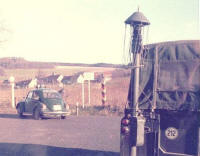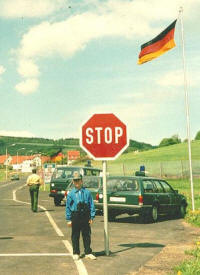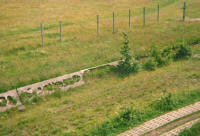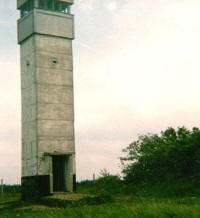| |
Crossing
the Border - Ober Fladungen and Melpers
Mike McGehee (Maj Ret)
We were on a month long leave that summer of 1990 at my
wife’s family West German (Federal Republic) dairy farm in Oberfladungen.
Those that were on the German-German border know the area as patrol vantage
point (PVP) 103 up on the far northwestern end of our former patrol sector.
The wall in Berlin had fallen the previous December and it wasn’t long
before the field between Melpers in the German Democratic Republic and the
road at PVP103 leading to the West German town of Oberfladungen was opened
to traffic from the East. Minefields were cleared and sections of the fence
that went up in 1975 started coming down.
New border crossing buildings sprang up on both side
of that field that had separated some families and two countries since the
raising of the Iron Curtain. When I visited the border area between
1980-1990, I always tried to let the squadron know I was present. In keeping
with this tradition, during my office call with the Eagle Horse Commander,
LTC Craig R. Lind in June 1990, I learned that he had called the
Bundesgrenschutz (BGS) that March and informed them that the squadron was no
longer pulling border duty.
I had first visited PVP 103 as a new Lieutenant
just arrived from Airborne School and Christmas leave. That first border
tour was in the winter of 1975. I think like most troopers viewing the
border for the first time, I felt a combination of interest and disgust. US
troopers were from an open society and familiar with all the freedoms of the
West. It was amazing to see a modern society based on fences, mine fields
and guard towers.
| |
|
|
|
|
| |
 |
|
 |
|
| |
This is 1977, on the border
during a Joint Patrol. The East German town in the background is
Melpers, in the VW, members of the Bavarian Border Police and to the
right, a BGS light utility vehicle. |
|
In 1990, the same spot as my
first son, Michael poses for a photo on the former border line.
|
|
| |
|
|
|
|
During that first visit, I not not know that
the land to the left side of the road belonged to my future father-in-law. I
stood in the same spot about fifteen years later with my oldest son Michael
T. and asked the West German official, who was waving the steady flow of
East German cars across, if it was ok for us to step a little ways into the
East. I wanted to get a picture of the backside of the minefield and fence.
His hearty response in German was something akin to “ sure, go as far as you
like, they don’t care and we don’t either”. Old habits and suspicions don’t
go away fast so we eased forward across the white painted line on the road
just far enough to make the photos and glass the East German control point
with the binocular. I could finally cross over that barrier that for so long
our border troopers could only get near. I took it all in; the new fence
where deadly anti-personnel mines once were attached, the plowed strip, and
the anti-vehicle ditch. It all seemed such a shame now that those folks were
locked up all those years.
Everyone was excited to see old friends and
relatives. Some East Germans had been able to cross before the border
opening if they were of an advanced age. I remember my sister-in-laws
relatives that came to her wedding in 1986. They were afraid to have their
picture taken! Now sort of “free “, the “Ostees”, or East Germans, were
treated to DM 100 as a welcome gift from the Federal Republic. I’m told that
they bought up every banana within 100 km of the border! Their little cars
with 2-cycle engines turned the sky blue and continued to pollute until they
started buying up all the available used cars in the West.
| |
|
|
|
|
| |
 |
|
 |
|
| |
A few years later on, after much
of the barrier system had been removed, these fragments of the
former East German anti vehicle ditch and the pre cast patrol road
sections in the Melpers area. |
|
The remains of one of the guard
towers. I believe this one was pulled down shortly after I took the
photo. |
|
| |
|
|
|
|
It was thirteen years later before I returned
for my second steps in the former GDR. February-March 2003 was a tense time
with war looming in Iraq and we were concerned we might not get a flight
home. Camp Lee was locked up and for sale and the only GIs I saw were at the
airport. The snow was beginning to melt and I decided to walk to, and then
on past PVP 103 and maybe go as far as the site of the concrete guard tower.
This was a moving experience for me. I stopped to read public announcements,
marveled at the old church, and waved to some of the villagers. It is hard
to imagine how their lives have changed since the reunification. I continued
on through the little village of Melpers to the spot where the tower once
stood. It was gone now. The road got steeper and turned northwest.
As a lieutenant, I remember watching traffic in
the form of a white colored bus move down this road bringing workers or
soldiers to the village. That was about the only traffic we saw then. In old
Melpers, all the lights went on at once, later at night, they all went off
at once. I’m not sure anyone really lived there. Now, if you weren’t
careful, you could get run over by the many cars traveling the once closed
road. The village was lively, people had opened the shops you’d expect to
see in any small town. I had seen enough on foot. Later that week I went
deeper into the East with my brother-in-law and nephew in their old VW. We
drove through a collective farm and saw some dual-purpose farm machinery
that could move cattle and missile launchers. The following week we went
even farther, visiting Meiningen and, when we had lunch at their local
McDonald’s, I knew that the Cold War was over forever! We drove further on
to the town of Suhl, once one of the major Soviet Army towns in the area.
The electric grid support poles, signage, and
the construction of high-rise apartment buildings contrasted with the West.;
there is a certain shabby look to the East and even with fresh paint, it is
recognizable. Slowly the two Germanys will fully merge although in the
newspapers, they think it will take a full generation. In the former West
Germany, the problems of unemployment and the post - industrial economy are
bad enough, the eastern side of the country has even more problems. The two
peoples once separated by miles of fence, guarded by border cavalry troopers
and others, are once again taking steps together. I am sure that this is a
good thing, time will tell.
|
|